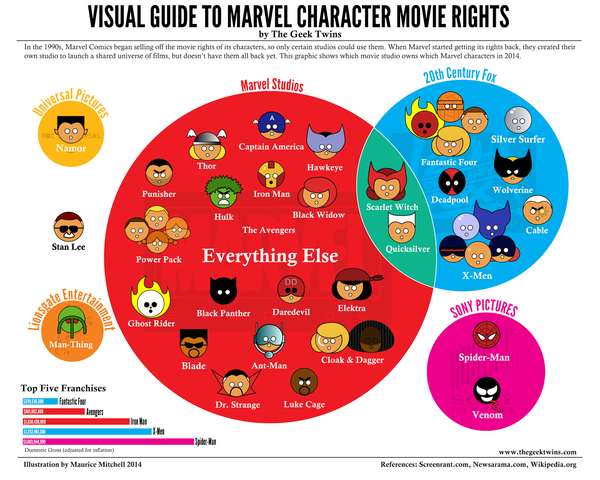
Every once in a while, someone asks exactly why, in the movies, the Avengers can’t recruit Spider-Man, or why no one ever calls up Wolverine. Marvel has built up a long publishing history of characters interacting with each other, and almost every major or minor Marvel hero has served as an Avenger at one point or another. As we know, the right are just about everywhere, and many heroes simply cannot legally interact.
The folks at The Geek Twins, however, have designed this helpful info-graphic to streamline this material completely, explaining where all characters reside. Ultimately, the big properties that exist on their own are Spider-Man and X-Men: the webslinger is destined to be at Sony Pictures pretty much forever, while the merry mutants have a seventh and an eighth film coming soon with Fox, in a deal that likely will not expire for a very long time. Fox also has the rights to The Fantastic Four and Silver Surfer: The Fantastic Four sees a release next summer, while the Surfer remains on ice for now. Rumors that the Surfer and his master Galactus would be gifted to Marvel so that Fox could retain the Daredevil rights proved baseless, as the horned hero, once the property of Fox, has now found a home back at Marvel.
While it’s not certain how definitive this graphic is, apparently Universal Pictures still has one Marvel project, Namor. There doesn’t seem to be any development on this property in recent years: Chris Columbus and Jonathan Mostow both flirted with directing years ago. And Lionsgate has retained the rights to Man-Thing, who starred in his own TV movie courtesy of director Brett Leonard (Lawnmower Man) years ago, one of the few lasting memories of the unlikely Marvel-Artisan partnership.
This graphic is ultimately far less complicated than it could have been. Marvel lost potential millions when they made the cheap decision to sell the cinematic rights to their characters for a penny on the dollar back in the seventies and eighties. In their nineties bankruptcy, they turned to Toy Biz head Avi Arad, who was able to buy back the rights to every major characters, even cheaper, from several low rent studios, some of whom were no longer in operation. His strategy was then to make good money selling them, at a proper price to the biggest studios. So in the early 00’s, during the time of Spider-Man, there would have been many more bubbles.
Ultimately, Marvel made the sort of sweetheart deals that ensured their properties would eventually return home, made more viable by prior ownership. A major mistake was selling a package of characters to Artisan, which folded into Lionsgate, including Captain America, Thor and The Punisher. Those properties eventually made their way back to Marvel, while Universal eventually regifted Hulk, New Line Cinema let go of Blade, Iron Man and Venom (who subsequently went to Sony) and Sony bid adieu to Ghost Rider.
Marvel likely holds out hope that they can return the Fantastic Four, Spidey and the X-Men into the Marvel fold, but right now that’s a pipe dream: the studios still see massive profit from those properties, while Marvel is still in the business of only making two big blockbusters a year. Sony and Fox are playing defense by building franchises inside of franchises, discussing The Sinister Six and X-Force as possible deterrents to losing rights, so this could very well be the status of Marvel properties for the next couple of decades.
Your Daily Blend of Entertainment News

